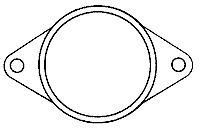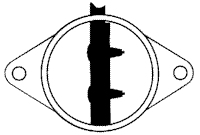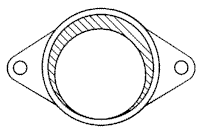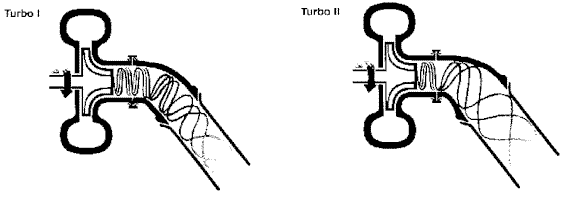Diesel Exhaust
Brakes:
Design and Performance
alert |
By: Gene McCrickard,
Advance Product Design
After forty-something years in the automotive aftermarket, I’ve
seen a lot. From the coolest, to the ridiculous…it’s all interesting in its own
way. For the most part, there is no need to get too excited over poor designs. The natural
course of things generally weeds out products that aren’t carefully thought through,
or just flat-out fail to perform. But, when I see a product that presents a potential
hazard to the consumer, I feel I must point it out. Such is the case with the latest trend
in diesel exhaust brakes.
The concept of diesel exhaust brakes represents good, solid,
creative engineering considering that the primary over-the-road use of most diesels is in
heavy load applications. The added safety, driveability and brake-saving benefits of using
engine back-pressure to control downhill speed are obvious. How those benefits are
achieved, as well as the design and engineering of the brake itself, is my concern.
Traditional diesel exhaust brakes are mounted in the exhaust system
a reasonable distance from the engine. This is a system tried and proven for decades in
heavy-duty, OTR applications. The latest trend in light-duty towing and recreational
vehicles is to mount the brake directly to the turbo by replacing of the elbow casting
that connects the exhaust pipe. Granted, installation is easier than the technique
required to install the traditional system. But considering performance, and the life of
the turbocharger, I have some serious reservations about the severe environment in which
these systems are expected to survive.
Let’s look at some common sense questions that should occur to
anyone with a mechanical background.
Performance: A lot of effort has been spent by the
automotive aftermarket to improve the performance of diesels in the recreational and
towing markets to overcome factory shortcomings. After four decades in the automotive
performance aftermarket, certain practices are "givens" in dealing with most
internal combustion engines. We know that if the air/fuel volume going into the cylinder
is increased, we get a bigger bang at combustion which translates into more power.
Likewise, the more efficiently we can scavenge the exhaust gases, the less the engine has
to work to expel those gases, and the more room there will be in the cylinder for the
incoming air/fuel charge. Why then, after years of switching to large bore exhaust systems
and high flow intake filters to improve performance, would you want to create a
restriction at the very source of the exhaust (i.e. the turbocharger outlet), that reduces
the inside area of the system? Take a look at the drawings in Figures A and B. Notice the
difference in the stock casting in Figure A, and the direct-bolt exhaust brake in Figure
B. By measuring the inside diameter of the casting of a direct-bolt system, and then
deducting the space taken up by the butterfly and shaft, we see that the exhaust pipe area
has been reduced by approximately 23% as illustrated in Figure C. That’s a
major hit! After working so hard to improve diesel performance, we have essentially
reversed the procedure for the sake of a convenient installation. How smart can that be?
Figure
A:
This represents the
unobstructed exhaust
opening as it comes from
the factory.
 |
Figure B:
This illustrates what the direct-mount brake looks like. Notice the butterfly
valve and supporting shaft that take up 23% of the total area of the exhaust opening.
 |
Figure C:
This illustrates the effective
reduction in exhaust pipe area when you deduct the space occupied by the butterfly valve
and shaft. The shaded area represents lost area.
 |
Durability: As previously stated, the traditional
exhaust brake system usually mounts downstream in the exhaust system, several feet from
the exhaust manifolds. This important distance effectively reduces the temperature of the
gases entering the brake. But what can we expect when the brake is bolted directly to the
back of the turbo? Exhaust temperatures at the turbine housing are outrageously high. In
fact, on a long uphill climb, temperatures get so hot you can actually see through the
turbocharger exhaust housing! I have to wonder what the life expectancy of a part
operating in this severe environment will be. And, when the part fails, where will the
vehicle be? Hopefully not on the downside of a hill it has just crested, where the exhaust
brake’s performance could be crucial.
The Turbo: I’m not sure how many hours of
testing these new brakes underwent in actual over-the-road evaluations before being
brought to market, but if I were the OEM supplier of diesel turbochargers, I’d have
some serious concerns about having an aftermarket part bolted to my product that reduced
the exhaust system’s efficiency, and in all likelihood, increased the temperature
inside my turbo.
Turbochargers generate a lot of additional heat not found in
normally aspirated engines. So much so, that coolers are required in many instances to
reduce the temperature of the air they compress for combustion. One would think that the
additional heat would have to affect the life of the turbocharger. And besides the turbo
itself, how about all the other parts operating in a close proximity to the turbo and
exhaust manifolds? If additional heat is generated, does it push surrounding parts to or
beyond their design limits for tolerance to heat? Inquiring minds want to know.
Safety: Traditional exhaust brakes are activated
electronically or with air pressure. Few other control systems approach the reliability of
electronics in this day and age, and the air pressure is generally supplied by an onboard
air source designed for that purpose. The new "behind-the-turbo" brakes however
are activated by vacuum.... again a compromise for ease of installation. The potential for
danger that exists when both of your braking systems are operating off the same vacuum
source worries me.
First of all, vacuum isn’t the strong point of a diesel engine.
The nature of these beasts routinely requires a supplemental vacuum system to make the
factory stuff operate reliably. So what’s the plan for hooking up the direct-mount
vacuum? Can you believe hooking it up to the brake boosters’ vacuum supply. Now if
for any reason the system loses vacuum (hose comes loose, belt failure, leak in the
canister), not only does the exhaust brake not function properly, you’ve lost the
needed assist for the hydraulic brakes as well. Does anyone see a problem with this
concept? Hello-o-o!
The exhaust brake that was supposed to assist and extend the life of
the factory brakes now has become the reason for them becoming virtually inoperable.
Personally, I would question selling or installing one of these systems if there were even
the possibility of this situation occurring!
Curiously, these systems are catching on. While I can understand the
desire to turn the job around quickly, the installation of these systems probably saves
only an hour over that of the conventional systems. That seems to be the only upside. And
while I’ve spent a lifetime designing performance aftermarket goodies for the
automotive and heavy-duty industries, I’ve always tried to consider the implications
of how my designs will impact the systems they influence as well as the vehicle as a
whole. Ultimately, an aftermarket upgrade should improve the overall system without
compromising the integrity and safety designed into the vehicle.
There will always be a better idea, simpler... easier... less
expensive, just around the corner. That’s what makes our industry so exciting. But
I’m not convinced that the direct-mount diesel exhaust brake is one of them.
Turbo I:
This is a simple illustration showing the set-up used on a
Dodge Ram with the Cummins engine. This set-up uses a cast iron adapter to compensate for
the tight proximity of the firewall. It exits into a 3", 14ga. pipe that has an area
of 6.33 sq. in. From a performance perspective, this is barely adequate.I would never recommend placing anything acting as a
divider in this area due to the hard swirl. The last thing you want is something slowing
down the swirl this close to the turbo where it is trying to expand rapidly. |
Turbo II:
This is my suggestion to improve on the factory design
with a rapid taper expanding to a 4", 16 ga. pipe to improve performance. This would
provide 11.76 sq. in. of area to improve flow, and provide faster conversion from the hard
swirl to a linear flow. This should happen before even considering a divider or
obstruction in the exhaust. My personal feelings are that you should be at least 18"
downstream before installing any kind of obstruction. |

Notice the area just behind the turbo as the
gases exit in a hard swirl and try to expand. |
Gene McCrickard is a design engineer, involved in
performance engineering for O.E. and aftermarket for over 40 years. A leading authority on
intake and exhaust flow technology, his most recent accomplishment is The Flow
Control™ racing air cleaners now owned and marketed by K&N Engineering.
Reprinted from Motorville Online at http://www.motorville.com
By permission of Mixed Media Marketing.
Return to Publications Page
Return to Home Page



